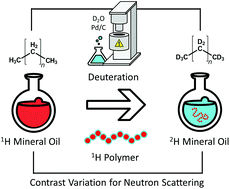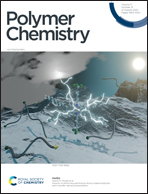Decagram scale production of deuterated mineral oil and polydecene as solvents for polymer studies in neutron scattering†
Abstract
Decagram scale syntheses of deuterated mineral oil (d-MO) and poly(1-decene) (d-PD) were achieved by direct catalytic hydrothermal H/D exchange reaction in D2O. Nuclear magnetic resonance (NMR), mass density and small angle neutron scattering (SANS) analyses collectively revealed deuteration ratios of 54 ± 12% and 88 ± 4% for d-MO and d-PD, respectively. Further SANS analyses of polyethylene (PE) dissolved in d-MO revealed that the oil behaved as a theta solvent at temperatures of 100 and 120 °C, based on assessments of the radii of gyration and mass-fractal dimensions in the PE coils. These results suggest that PE chains in d-MO likely adopt the same coiled molecular conformations as those reported for PE in the molten state. This approach of deuterating the oil solvent, in lieu of the polymer analyte, may have far reaching applications for the SANS assessments of oil additives in polymer materials. Additionally, such deuterated oils are expected to exhibit improved stability and oxidative resistance, which will benefit many applications given the ubiquitous use of mineral oil in industry.



 Please wait while we load your content...
Please wait while we load your content...